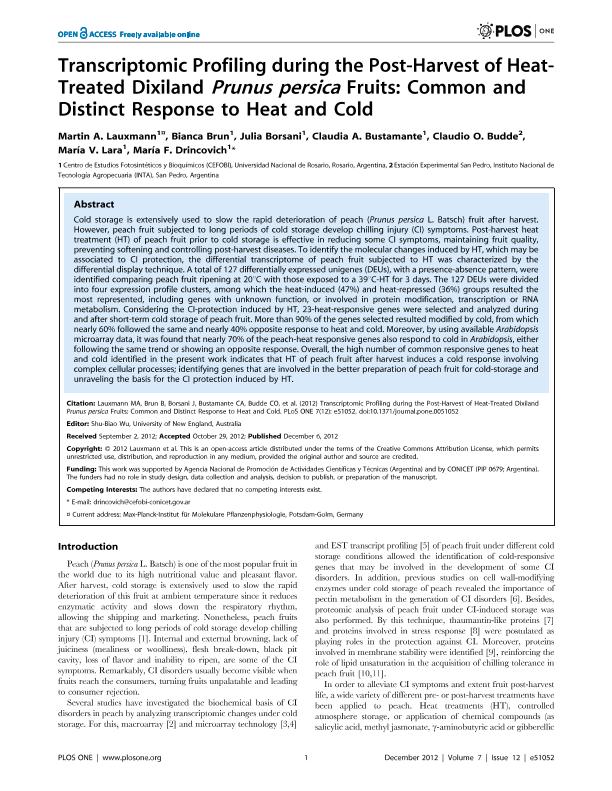Mostrar el registro sencillo del ítem
dc.contributor.author
Lauxmann, Martin Alexander

dc.contributor.author
Brun, Bianca
dc.contributor.author
Borsani, Julia

dc.contributor.author
Bustamante, Claudia Anabel

dc.contributor.author
Budde, Claudio
dc.contributor.author
Lara, Maria Valeria

dc.contributor.author
Drincovich, Maria Fabiana

dc.date.available
2017-01-12T20:34:55Z
dc.date.issued
2012-12
dc.identifier.citation
Lauxmann, Martin Alexander; Brun, Bianca; Borsani, Julia; Bustamante, Claudia Anabel; Budde, Claudio; et al.; Treated Dixiland Prunus persica Fruits: Common and Distinct Response to Heat and Cold; Public Library Of Science; Plos One; 7; 12; 12-2012; 1-16
dc.identifier.issn
1932-6203
dc.identifier.uri
http://hdl.handle.net/11336/11249
dc.description.abstract
Cold storage is extensively used to slow the rapid deterioration of peach (Prunus persica L. Batsch) fruit after harvest. However, peach fruit subjected to long periods of cold storage develop chilling injury (CI) symptoms. Post-harvest heat treatment (HT) of peach fruit prior to cold storage is effective in reducing some CI symptoms, maintaining fruit quality, preventing softening and controlling post-harvest diseases. To identify the molecular changes induced by HT, which may be associated to CI protection, the differential transcriptome of peach fruit subjected to HT was characterized by the differential display technique. A total of 127 differentially expressed unigenes (DEUs), with a presence-absence pattern, were identified comparing peach fruit ripening at 20°C with those exposed to a 39°C-HT for 3 days. The 127 DEUs were divided into four expression profile clusters, among which the heat-induced (47%) and heat-repressed (36%) groups resulted the most represented, including genes with unknown function, or involved in protein modification, transcription or RNA metabolism. Considering the CI-protection induced by HT, 23-heat-responsive genes were selected and analyzed during and after short-term cold storage of peach fruit. More than 90% of the genes selected resulted modified by cold, from which nearly 60% followed the same and nearly 40% opposite response to heat and cold. Moreover, by using available Arabidopsis microarray data, it was found that nearly 70% of the peach-heat responsive genes also respond to cold in Arabidopsis, either following the same trend or showing an opposite response. Overall, the high number of common responsive genes to heat and cold identified in the present work indicates that HT of peach fruit after harvest induces a cold response involving complex cellular processes; identifying genes that are involved in the better preparation of peach fruit for cold-storage and unraveling the basis for the CI protection induced by HT.
dc.format
application/pdf
dc.language.iso
eng
dc.publisher
Public Library Of Science

dc.rights
info:eu-repo/semantics/openAccess
dc.rights.uri
https://creativecommons.org/licenses/by-nc-sa/2.5/ar/
dc.subject
Prunus Persica
dc.subject
Chilling Injury
dc.subject
Heat Treatment
dc.subject.classification
Bioquímica y Biología Molecular

dc.subject.classification
Ciencias Biológicas

dc.subject.classification
CIENCIAS NATURALES Y EXACTAS

dc.title
Treated Dixiland Prunus persica Fruits: Common and Distinct Response to Heat and Cold
dc.type
info:eu-repo/semantics/article
dc.type
info:ar-repo/semantics/artículo
dc.type
info:eu-repo/semantics/publishedVersion
dc.date.updated
2016-11-17T16:03:42Z
dc.journal.volume
7
dc.journal.number
12
dc.journal.pagination
1-16
dc.journal.pais
Estados Unidos

dc.journal.ciudad
San Francisco
dc.description.fil
Fil: Lauxmann, Martin Alexander. Consejo Nacional de Investigaciones Científicas y Técnicas. Centro Científico Tecnológico Rosario. Centro de Estudios Fotosintéticos y Bioquímicos (i); Argentina. Universidad Nacional de Rosario; Argentina
dc.description.fil
Fil: Brun, Bianca. Consejo Nacional de Investigaciones Científicas y Técnicas. Centro Científico Tecnológico Rosario. Centro de Estudios Fotosintéticos y Bioquímicos (i); Argentina. Universidad Nacional de Rosario; Argentina
dc.description.fil
Fil: Borsani, Julia. Consejo Nacional de Investigaciones Científicas y Técnicas. Centro Científico Tecnológico Rosario. Centro de Estudios Fotosintéticos y Bioquímicos (i); Argentina. Universidad Nacional de Rosario; Argentina
dc.description.fil
Fil: Bustamante, Claudia Anabel. Consejo Nacional de Investigaciones Científicas y Técnicas. Centro Científico Tecnológico Rosario. Centro de Estudios Fotosintéticos y Bioquímicos (i); Argentina. Universidad Nacional de Rosario; Argentina
dc.description.fil
Fil: Budde, Claudio. Instituto Nacional de Tecnologia Agropecuaria. Centro Regional Buenos Aires Norte. Estacion Experimental Agropecuaria San Pedro; Argentina
dc.description.fil
Fil: Lara, Maria Valeria. Consejo Nacional de Investigaciones Científicas y Técnicas. Centro Científico Tecnológico Rosario. Centro de Estudios Fotosintéticos y Bioquímicos (i); Argentina. Universidad Nacional de Rosario; Argentina
dc.description.fil
Fil: Drincovich, Maria Fabiana. Consejo Nacional de Investigaciones Científicas y Técnicas. Centro Científico Tecnológico Rosario. Centro de Estudios Fotosintéticos y Bioquímicos (i); Argentina. Universidad Nacional de Rosario; Argentina
dc.journal.title
Plos One

dc.relation.alternativeid
info:eu-repo/semantics/altIdentifier/url/http://journals.plos.org/plosone/article?id=10.1371/journal.pone.0051052
dc.relation.alternativeid
info:eu-repo/semantics/altIdentifier/doi/http://dx.doi.org/ 10.1371/journal.pone.0051052
Archivos asociados
